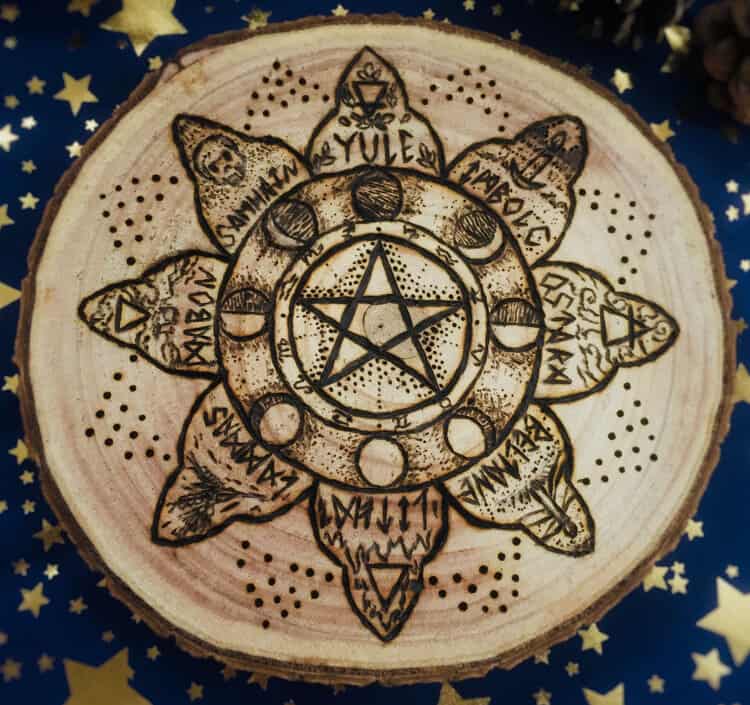The pentagram means different things to different people. Meanings have changed over time. The pentagram was commonly seen as a symbol for good and for protection against evil across the board.
Figuring out the meaning of the pentagram is a very interesting quest. Since the pentagram is one of the oldest markings known to us and with it comes many different meanings to many different groups of people. The symbol itself should not be feared. We all should be aware of what other people are communicating through it. Fundamentally, the pentagram is a symbol filled with mystery, intrigue, and meaning.
It is also a symbol of controversy. This simple and elegant symbol has had a varied existence. and this is reflected by the fact that it can be found as a symbol of importance, around the world, in many different cultures and religions. At some point in time, nearly all religions and spiritual groups have had beliefs that have incorporated the pentagram. In the 15–16th century occultist Heinrich Cornelius Agrippa (who was an acknowledged philosopher and expert on occultism) popularized the idea that the pentagram was a magical symbol. He commended magick as the best means for people to really know Deity and nature in all it’s wonder.
Now lets take a deeper look into the meaning of the pentagram. Let this help you discover what the pentagram can really mean to you.
RECEIVE NEW
ARTICLES
EVERY WEEK!
Never miss out again! Be the first to read the newest posts to help you continue learning & expanding your knowledge!
THE MEANING OF THE PENTAGRAM
Approaching the meaning of the pentagram means taking a look at the history of the pentagram. The history of the pentagram is rife with myths, suspicious claims and iconoclasm. Along the way you can ask yourself the following questions: Why does it matter to me? Is it important for the pentagram to means only one true thing? Is it just a symbol representing our active projections at this very moment in time? Is it necessary to attribute ancient and mysterious origins to establish its credibility? Why do we look to the past for answers if being spiritual/religious is about our here and now? What is the fascination with always looking back for answers? Why do I/we have the inclination to shun anything new? What is it you are interested in and/or looking for?
The Pentagram: Wiccan & Pagan Perspective
The pentagram is the preferred symbol of Wicca and other Pagan religions. For Pagans (which includes Wiccans and Witches alike) the pentagram represents the four elements and spirit (fire, water, earth, air and spirit). People practicing Pagan faiths can often be seen wearing jewelry incorporating the pentagram symbol. For Pagans, the single point upwards represents spirit presiding over the four elements of matter. The many Pagan groups from the past and those who are around today, use the pentagram in all types of rituals and decorations because the meaning to them is that it symbolizes infinity.
The pentagram for Pagans symbolizes the binding of the five elements, and protection of the self. For Pagan’s the open pentagram represents an open, active approach. A circled pentagram contains and protects. The circle symbolizes eternity, infinity, the cycles of life and nature. It is also tied to the female planet Venus because every 8 years Venus traces a perfect pentagram across the sky. This is why the pentagram is also a symbol for the sacred female for people practicing the Pagan based faiths.
The Pentagram: Taoism Perspective
Taoism, is a philosophical and spiritual tradition of Chinese origin which emphasizes living in harmony with everything that exists in nature & in our universe. The meaning behind the pentagram for Taoists is the representation of the five oriental elements: earth, water, wood, fire, and metal (also referred to as the five phases). The pentagram (five elements) emphasizes cyclic transformations and change.
The Pentagram: Japanese Perspective
In Japanese culture the symbol is considered magical. The pentagram is a symbol of magical power, associated with the onmyoji, Abe no Seimei. It is a diagram of the “overcoming cycle” of the five Chinese elements: earth, air, water, wood and metal. Because Japan is a predominantly non-Christian country with their own set of associations attached to the pentagram symbol, there is no social stigma associated with it.
The Pentagram: Ancient Sumerian Perspective
From an Ancient Sumerian perspective, the symbol was used to represent the human Physical body and Elemental form. The five points of the pentagram were believed to represent either 1) the four corners of the earth and “the vault of heaven,” or 2) the five visible planets in our night sky: Jupiter, Mercury, Mars, Saturn, and Venus (with Venus a representative of the Queen of Heaven).
The Pentagram: Christian Perspective
When we think about the pentagram we tend not to associate it with Christianity however, the pentagram was used as a Christian symbol. The five points of the pentagram were used to represent the five wounds that Jesus Christ received during his crucifixion (the nails in Jesus’s hands , his feet and the spear wound in his side). The Christians also use it as a Christian symbol to represent the five senses and and as a symbol to ward off demons in the medieval era.. However, in later times it was taken by Christianity and said to mean the devil in order to destroy beliefs of the Pagan Old religions and to rid any reference of females being sacred.
The Pentagram: Judaism Perspective
The pentagram has been used in Judaism when it first was used as the stamp of Jerusalem. The pentagram was the official seal of Jerusalem at around 300-150 BCE. In the Jewish kabbalistic tradition, the pentagram represents justice, mercy, wisdom, understanding, and transcendent splendor.
The Pentagram: Satanist Perspective
During the twentieth century the pentagram became associated with Satanism. This is believed to be due to misinterpretation of symbols used by ceremonial magicians. Satanists (especially members of the Church of Satan) choose to use an upside-down pentacle (which is a pentagram within a circle) as the symbol for their religion. Éliphas Lévi said that when ever a pentagram was turned upside down it signified evil. So instead of the pentagram having the one point projecting upwards, the Satanist have the pentagram with two points projecting upwards.
Satanist say it is a symbol of evil and attracts sinister forces because it overturns the proper order of things. Éliphas Lévi claimed that the Pentagram expresses the mind’s domination over the elements and it is by this sign that we bind the demons of the air, the spirits of fire, the specters of water, and the ghosts of earth. Satanists say that turning the pentagram upside down demonstrates the “victory of matter over spirit”.
The official Church of Satan has a goats head at the center of the pentagram called the sigil of Baphomet. To a Satanist, it is the goat of lust attacking the heavens with its horns. The inverted pentagram has associations black magick. Here’s a quote from Éliphas Lévi, Dogme et Rituel de la Haute Magie “The Pentagram is the figure of the human body, having the four limbs and a single point representing the head. A human figure head downwards naturally represents a demon that is, intellectual subversion, disorder or madness”.
The Pentagram: Pythagorean Perspective
Pythagoreanism originated in the 6th century BC and used the pentagram as a symbol of mutual recognition and of wellbeing. The Pythagoreans called the pentagram, Hygieia (meaning health in Greek and also the name of the Greek goddess of health, Hygieia), and saw in the pentagram a mathematical perfection which would later come to be known as the Golden ratio. The pentagram was called the pentalpha by the Greeks who believed it had magical properties
The pentagram: Folklore Perspective
The pentagram in folklore is used as a apotropaic symbol. This means that it was used as a symbol to ward off evil influences (especially in European folk magic). The use of the pentagram symbol in German folklore (called Drudenfuss in German) is referred to by Goethe in Faust (1808), where a pentagram prevents Mephistopheles (a demon) from leaving a room. The pentagram was only considered effective if drawn perfectly.
The Pentagram: Babylonian Perspective
Ancient Babylonian use of the pentagram as an apotropaic charm to protect against evil forces. Babylonian priests associated the pentagram with Ishtar, the goddess of love. Some believe the pentagram actually comes from Babylon as it was first found in the Uruk IV period (ca. 3300-3100BC) as a Sumeric pictographic symbol.
NOTE: Always bear in mind that it is difficult to clearly ascertain exactly what the pentagram meant to ancient peoples due to the lack of thorough documentation available to us today. The pentagrams exact meaning at this time is unclear.
Ref: Elisa Prato Dipartimento di Matematica Applicazioni per l’Architettura
The Pentagram: Freemason Perspective
The Order of the Eastern Star, an organization associated with Freemasonry, uses a pentagram as its symbol, with the five triangles of the points colored blue, yellow, white, green and red. Their version of the symbol is constructed from five lines of equal length, creating five isosceles triangles with a pentagon in its center. From a Freemason point of view, a pentagram represents the Golden Ratio, which as previously mentioned, is a mathematical idea found in architecture, finance, and nature.
The Pentagram: Occultist Perspective
Heinrich Cornelius Agrippa was an a German polymath, physician, legal scholar, soldier, theologian, and occult writer. He associated the five points of the pentagram with the five Neo-Platonist elements, and also associated them with five classical planets. This can be seen or shown as a figure of the human body pentagram, with Mars, Saturn, Venus, Jupiter, and Mercury. These five planets would also have had alchemical associations associated with them.
NOTE: As will be seen, all mysteries of magic, all symbols of the gnosis, all figures of occultism, all kabbalistic keys of prophecy, are summed up in the sign of the pentagram, which Paracelsus proclaims to be the greatest and most potent of all signs.
Ref. Éliphas Lévi, “Dogme et Rituel de la Haute Magie”
What is the Difference Between the Pentagram and Pentacle?
Pentagram is just the star (from the Greek words (pentagrammon) “five” + (grammē) “line”). Where as a Pentacle is the star within a circle.
NOTE: the term “pentacle” can refer to all kinds of magical symbols not only pentagrams. Pentagrams are often incorporated into pentacles, but not all pentacles contain pentagrams.
CONCLUSION:
The meaning behind the pentagram is as varied and variable as all the people who exist to define it. So the pentagram is a symbol of what exactly?? the answer … it all depends who you ask! The main thing is what it means to you and how you incorporate it into your way of life. Do your own research and follow your own intuition. You know what is right for you.
RECEIVE NEW
ARTICLES
EVERY WEEK!
Never miss out again! Be the first to read the newest posts to help you continue learning & expanding your knowledge!











